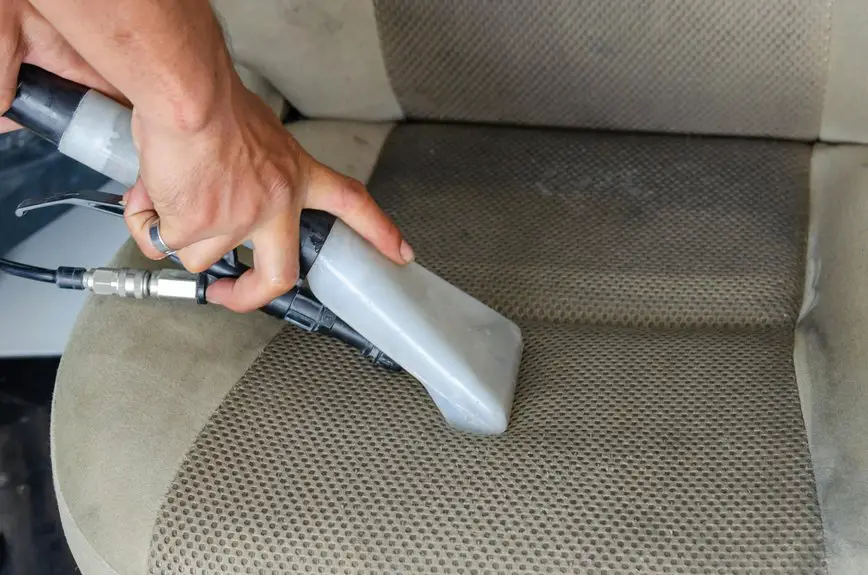To remove chocolate stains from upholstery, first identify your fabric type to avoid damage. Gently scrape off excess chocolate without rubbing. For fresh stains, blot with a clean cloth, then apply a mild cleaning solution, testing it on a hidden area first. For dried stains, carefully loosen residue and use an upholstery cleaner or a homemade mix of vinegar and dish soap. Acting fast helps prevent setting. Keep going to discover more tips for thorough stain removal and upkeep.
Table of Contents
Key Takeaways
- Gently scrape off excess chocolate with a dull knife and blot fresh stains with a clean, dry cloth to avoid spreading.
- Test any cleaning solution on a hidden spot before applying to the stained area to prevent fabric damage.
- Use a mild upholstery cleaner or a homemade mix of white vinegar and dish soap for fresh stains, blotting gently.
- For dried stains, carefully scrape residue, vacuum loose particles, then apply enzyme-based cleaners for effective stain breakdown.
- Act quickly, keep cleaning supplies nearby, and consider slipcovers to prevent and manage future chocolate stains on upholstery.
Identifying the Type of Upholstery Fabric
Before you tackle a chocolate stain, you need to know what type of fabric you’re dealing with. Different upholstery fabrics react differently to cleaning methods, so identifying the material helps you avoid damage.
Start by checking the manufacturer’s tag for fabric information and care instructions. If there’s no tag, examine the texture and weave: natural fibers like cotton and linen feel soft and breathable, while synthetics such as polyester or nylon often feel smoother or slightly plastic-like.
Velvet and suede require special care due to their delicate nature. You can also do a small water test on an inconspicuous area—if water absorbs quickly, it’s likely natural fiber; if it beads up, it’s synthetic.
Knowing your fabric type sets the stage for effective and safe stain removal.
Preparing the Stained Area for Cleaning
Before you start cleaning, gently remove any excess chocolate from the upholstery to prevent it from spreading.
Next, always test your cleaning solution on a hidden spot to make sure it won’t damage the fabric.
Taking these steps will help protect your upholstery and improve stain removal.
Clear Excess Chocolate
Although it might be tempting to dive straight into cleaning, you need to clear off any excess chocolate first to prevent it from spreading or embedding deeper into the fabric.
Start by gently scraping off the hardened chocolate with a dull knife or a spoon, working carefully to avoid pushing it further into the upholstery. If the chocolate is soft, use a clean, dry cloth or paper towel to blot and lift as much as possible without rubbing.
Be patient and avoid applying too much pressure, which can worsen the stain. Removing this excess layer sets the stage for effective cleaning, so take your time to guarantee you’ve lifted all loose chocolate before moving on.
This step minimizes stain spread and makes the next cleaning process more efficient.
Test Cleaning Solution
How do you know if your cleaning solution is safe for your upholstery?
Before applying any cleaner to the chocolate stain, test it on a hidden spot, like the back or underside of the fabric. Apply a small amount and wait 10 minutes. Check for any discoloration, fading, or fabric damage.
If the area looks unchanged, you’re good to go. If you notice any adverse effects, stop and try a different cleaner. Testing prevents further damage and guarantees your upholstery stays intact.
Always follow the manufacturer’s instructions for both the cleaner and your furniture.
Once you confirm safety, you can confidently proceed to treat the chocolate stain without risking harm to your upholstery. This simple step saves time and preserves your furniture’s appearance.
Removing Fresh Chocolate Stains
When you catch a fresh chocolate stain on your upholstery, act quickly to prevent it from setting. First, gently scrape off any excess chocolate with a dull knife or spoon. Avoid rubbing, as it can spread the stain. Next, blot the area with a clean, dry cloth to absorb as much moisture as possible.
Use a mild cleaning solution to treat the stain. Here’s a quick guide:
| Step | Action |
|---|---|
| 1. Scrape | Remove excess chocolate gently |
| 2. Blot | Absorb moisture, don’t rub |
| 3. Clean | Apply mild solution, blot dry |
Remember to always test your cleaning solution on an inconspicuous spot before applying it to the stain. This approach helps keep your upholstery looking fresh and stain-free.
Treating Dried Chocolate Stains
Dealing with dried chocolate stains on upholstery requires a slightly different approach than fresh ones.
First, gently scrape off any hardened residue using a dull knife or spoon—avoid rubbing, which can push the stain deeper.
Start by carefully scraping off hardened chocolate with a dull knife or spoon—never rub to avoid embedding the stain.
Next, vacuum the area to remove loose particles without spreading the stain.
Finally, test a mild upholstery cleaner on a hidden spot to verify it won’t damage the fabric.
Once confirmed, apply the cleaner to the stained area and blot with a clean cloth, working from the outside in to prevent spreading.
Patience is key; dried stains need gentle, repeated treatments rather than aggressive scrubbing.
This method protects your upholstery while effectively lifting dried chocolate stains, making your cleaning efforts more successful and less stressful.
Using Homemade Cleaning Solutions
You can tackle chocolate stains effectively with simple homemade cleaning solutions using common ingredients like baking soda, vinegar, and dish soap.
Apply these mixtures carefully to avoid damaging your upholstery, using gentle blotting or dabbing motions.
With the right technique, you’ll see those stubborn stains start to fade quickly.
Ingredients for Homemade Cleaners
Although commercial stain removers are effective, homemade cleaning solutions offer a safer and more affordable way to tackle chocolate stains on upholstery.
You can easily gather common household ingredients that work wonders without harsh chemicals.
Here are three essential ingredients you should have on hand:
- White vinegar – Its mild acidity breaks down chocolate oils and lifts stains effectively.
- Baking soda – Acts as a gentle abrasive and deodorizer, helping to absorb excess moisture and residue.
- Liquid dish soap – Cuts through grease and chocolate fats, making the stain easier to remove.
Combining these ingredients creates a powerful, natural cleaner that’s gentle on fabric but tough on chocolate stains.
Keep these items ready for quick, effective stain treatment anytime.
Application Techniques
Now that you’ve gathered the key ingredients for homemade cleaners, it’s time to learn how to apply them effectively to your upholstery.
Start by gently blotting the chocolate stain with a clean cloth to remove any excess residue. Next, dip a soft sponge or cloth into your homemade solution—avoid soaking it to prevent overwetting.
Lightly dab the stained area, working from the outside toward the center to stop the stain from spreading. Give the solution a few minutes to break down the chocolate but don’t let it dry completely.
Use a clean, damp cloth to blot away the cleaner and loosened chocolate. Finally, pat the area dry with a dry towel, ensuring no moisture remains that could cause damage or mold growth.
Stain Removal Tips
When tackling chocolate stains with homemade solutions, it’s important to act quickly and avoid rubbing the fabric harshly. Instead, gently blot the stain to lift excess chocolate without pushing it deeper.
To effectively remove the stain, follow these tips:
- Mix a teaspoon of dish soap with a cup of cold water and apply it with a clean cloth, blotting gently.
- Use a solution of equal parts white vinegar and water to break down the stain’s oils, applying it sparingly.
- Rinse the area with a damp cloth to remove any soap or vinegar residue, then blot dry with a towel.
When to Use Commercial Upholstery Cleaners
If you’ve tried basic cleaning methods and the chocolate stain still lingers, it’s time to contemplate commercial upholstery cleaners. These products are designed to tackle tough stains and refresh your fabric without damage. Use them when homemade solutions aren’t effective or when the stain has set in. Always check the cleaner’s label for fabric compatibility to avoid discoloration or weakening of fibers.
| Situation | Recommended Cleaner Type | Why Use It |
|---|---|---|
| Fresh, small stain | Mild upholstery cleaner | Gentle, prevents fabric damage |
| Stubborn, old stain | Enzyme-based cleaner | Breaks down protein stains |
| Delicate fabric | Specialized fabric cleaner | Protects delicate fibers |
| Unknown fabric type | Test patch first | Guarantees no adverse reactions |
Preventing Future Chocolate Stains on Upholstery
After tackling tough chocolate stains with commercial cleaners, you’ll want to take steps to avoid future messes.
Preventing stains is easier than constant cleaning. Here are three practical tips:
Preventing stains beats constant cleaning—simple habits make all the difference in keeping your space spotless.
- Set clear eating zones: Limit chocolate consumption to the kitchen or dining area. This reduces the chance of spills on upholstery.
- Use washable covers: Slipcovers or throws protect your furniture and are easy to clean if accidents happen.
- Keep cleaning supplies handy: Have stain removers or wipes nearby for quick action, stopping stains from setting in.
Frequently Asked Questions
Can Chocolate Stains Cause Permanent Damage to Upholstery Fabric?
Yes, chocolate stains can cause permanent damage if you don’t act quickly. You’ll want to treat the stain promptly to avoid fabric discoloration or setting, which makes it much harder to remove later on.
Are Chocolate Stains Harmful to Pets or Children on Upholstery?
Ever worry if that chocolate on your couch could hurt your kids or pets? While small amounts usually aren’t toxic, chocolate contains theobromine, which can be harmful to pets, so you should clean it up quickly to keep them safe.
How Long Should I Wait Before Cleaning a Chocolate Stain?
You shouldn’t wait long to clean a chocolate stain; acting quickly helps prevent it from setting. Blot the excess gently, then start cleaning as soon as possible for the best chance of removing the stain completely.
Can Chocolate Stains Be Removed From Leather Upholstery?
Yes, you can remove chocolate stains from leather upholstery. You’ll want to gently wipe the area with a damp cloth and mild soap, then condition the leather afterward to keep it soft and prevent damage.
What Should I Avoid When Cleaning Chocolate Stains on Upholstery?
Don’t let haste become your enemy; avoid scrubbing chocolate stains aggressively, using hot water, or harsh chemicals. These can spread the stain or damage fabric. Instead, treat gently with cold water and mild detergent for best results.
- The Role of Nonwoven Fabrics in Filtration Systems - July 11, 2025
- Can You Recycle Nonwoven Polypropylene Bags? - July 11, 2025
- How to Care for Your Nonwoven Polypropylene Tote Bags - July 11, 2025







